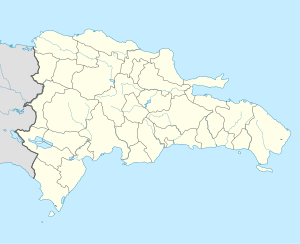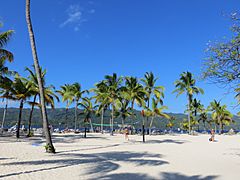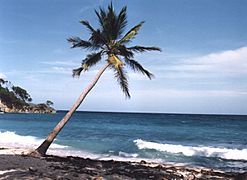Samaná Bay facts for kids
Samaná Bay (which is Bahía de Samaná in Spanish) is a large bay located in the northeast part of the Dominican Republic. It lies just south of the Samaná Peninsula. Long ago, Christopher Columbus called this bay "Golfo de las Flechas," meaning "Gulf of Arrows."
This beautiful bay is about 65 kilometers (40 miles) wide from east to west. It stretches about 25 kilometers (16 miles) from north to south. Several rivers flow into Samaná Bay. The Yuna river is one of the most important rivers on the island of Hispaniola. Other rivers that empty into the bay include the Barracote and the Yabón.
Contents
Islands and Beaches
Samaná Bay is home to many small, flat islands called cays. Many of these cays have lovely beaches that attract lots of tourists.
Cayo Levantado
One of the most famous cays is Levantado Cay, known as Cayo Levantado in Spanish. This cay is large enough to have its own hotel. It's a popular spot for visitors to relax and enjoy the clear waters.
National Park Los Haitises
On the southwest side of Samaná Bay, you'll find a special protected area called National Park Los Haitises. This national park is a natural treasure.
Plants and Animals
Los Haitises National Park is home to many interesting plants and animals. It's a great place to explore nature and see different kinds of wildlife in their natural habitat.
Amazing Wildlife
Samaná Bay is famous for its incredible marine life. You can often see Dolphins swimming and playing in the bay throughout most of the year.
Humpback Whales
One of the most exciting things about Samaná Bay is the arrival of humpback whales. These giant whales travel all the way from colder northern waters. They come to Samaná Bay to breed and give birth during the winter and spring months.
After their time in the warmer bay, the whales return to the colder waters where there is more food. Watching these magnificent whales is a very important business in the Samaná Province. Many people visit the area in late winter and early spring just to see them.
History of Samaná Bay
Samaná Bay has a rich history. In the 1800s, powerful countries like France, England, and the United States were interested in controlling the bay. They wanted to control the Samaná Peninsula and the bay to have power over the Caribbean Sea.
Before that time, the bay was a frequent stopping point for pirates. They used its hidden coves and strategic location.
Cities Around the Bay
Several important cities are located around Samaná Bay.
Northern Cities
On the northern side of the bay, in the Samaná Province, you'll find the cities of Santa Bárbara de Samaná and Sánchez. Sánchez was once a very important international port for the Dominican Republic. This was especially true during the late 1800s and early 1900s.
Southern Cities
On the southern side of the bay, in the Hato Mayor Province, is the city of Sabana de la Mar. These cities play a key role in the life and economy of the bay area.
Gallery
-
An old railway in the National Park Los Haitises
Images for kids
See also
 In Spanish: Bahía de Samaná para niños
In Spanish: Bahía de Samaná para niños







